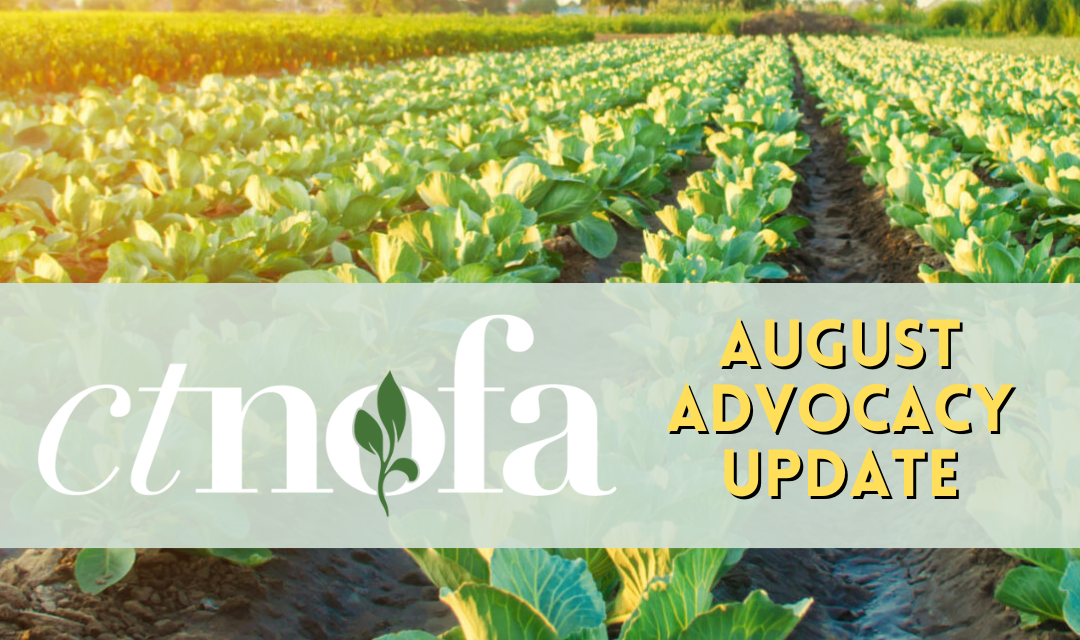August Advocacy Update

August 7, 2023
A Farm Bill that Supports the Future of Farming in the Face of Climate Change
From Dr. Kimberly Stoner, CT NOFA Director of Advocacy
Once every five years, we the people have an opportunity to push the US Congress to make fundamental change to how the US Department of Agriculture influences farming and the food system through the Farm Bill. That opportunity is open now, while “marker bills” — concepts that could be incorporated into the final Farm Bill — are still circulating.
The seven NOFA chapters and MOFGA (Maine Organic Farmers and Gardeners Association) have identified a few major priorities and marker bills to incorporate our priorities into the Farm Bill (sign on to take action on those here). One of these is the Agriculture Resilience Act.
Farmers have to cope with increasingly erratic weather — droughts, floods, warm winters, blasts of cold from the polar vortex, and heat waves that can last for weeks. Even though we have a relatively mild climate, Connecticut has been affected, too. We have had two climate-related disasters affecting agriculture in just the last few months: first a series of weather fluctuations (unusually warm spring followed by a devastating late frost) that killed off the flowers and thus the fruit for orchards all over the state, and then major flooding from the torrential rains here and further north in July, sending floodwaters to drown farmland along the Connecticut River.
The Agriculture Resilience Act would build up the capacity of the US Department of Agriculture and the food system to become more resilient in the face of these disasters and to reduce the greenhouse gas emissions of agriculture and the food system at the same time. Among the goals it would set are:
- Agriculture sector at net zero greenhouse gas emissions by 2040
- Expanding adoption of soil health practices to reduce nitrous oxide emissions (a very powerful greenhouse gas) from agricultural soils by 75%
- Increasing soil carbon by 0.4% annually on all agricultural lands
- Cover crops or continuous living cover on 75% of all cropland
- Converting 30% of grain cropland to perennial cropping systems
- Reducing greenhouse gas emissions from feeding ruminants by 50%
- Reducing food waste by at least 75% and composting or otherwise diverting from landfills 90% of unavoidable food waste
These are very ambitious goals! Can the US Department of Agriculture achieve them? A massive change would be required in the USDA, in the culture of the farming community, and in the rest of the food system, but the Agriculture Resilience Act would shift the considerable weight of agricultural research, extension, conservation, crop insurance, and other programs in the direction of resilience.
What can we do?
- Send a letter to your Congressional Representative and Senators through the NOFA webpage, here. (Rep. Jahana Hayes, representing northwest CT is on the House Agriculture Committee and is especially important at this time.)
- For extra emphasis on the Agriculture Resilience Act, send a separate email specifically asking them to co-sponsor this marker bill — use the name Agriculture Resilience Act and numbers S.1016 and H.R.1840.
- Continue to follow the Farm Bill. Congress moves very slowly these days, but they will need to take action on the Farm Bill before the end of the year.
Recent Posts
Nominations for the 2026 Bill Duesing ‘Organic Living on the Earth’ Award Now Open
Each year, at our winter conference, CT NOFA confers the Bill Duesing Organic Living on the Earth award to a notable individual who or group which exemplifies the life mission of our founder, Bill Duesing, to improve and enrich our world through organic advocacy and practices.
Nominees for this award are suggested by our community – that’s you!
Read MoreRequest for Workshop Proposals for CT NOFA’s 2026 Winter Conference
The CT NOFA Winter Conference educational slate of workshops is made possible thanks to the interest and enthusiasm of our knowledgeable community members. Are you an expert on a topic that would be of interest to conference attendees? We’d love to hear from you.
Read More

